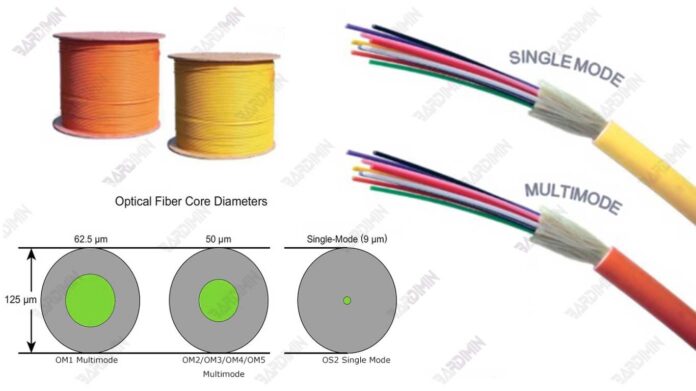Fiber optics has become the backbone of modern communication networks, providing fast, reliable, and efficient transmission lines for transferring large amounts of data. Compared to conventional copper cables, fiber optics offers significant advantages in transmission speed, reliability, and distance.
Single mode and dual mode are the two main types of configurations used in optical fibers, and the selection between them depends on the network’s specific needs.

1. Single Mode:
- Single mode uses optical fiber with a tiny core, usually about 9 micrometers.
- In single mode, light propagates through the fiber core in a direct path, allowing data transmission over very long distances at high speeds.
- Single mode is suitable for long-distance applications, such as metro networks and backhaul networks, where transmission speed and reliability are critical.
2. Dual Mode (Multi-Mode):
- Dual mode uses optical fiber with a larger core, usually between 50 to 100 micrometers.
- In dual mode, light can propagate through multiple paths (modes) within the fiber core, allowing for data transmission over shorter distances compared to single mode.
- Dual mode is suitable for short-range applications, such as local networks (LANs) in office buildings or data centers, where speeds remain high but transmission distances are relatively short.
Single Mode Optical Fiber
Single-mode fiber is a type of optical fiber designed to transmit light in single mode or single mode. This means light propagates within the fiber core directly, without bouncing off the core walls. The main characteristic of single-mode fiber is a very small fiber core, usually about 9 micrometers. This small core allows light to propagate in a direct path with little dispersion, allowing fast and reliable data transmission.
When light is fed into a single-mode fiber, it enters the fiber core and moves in a straight line along the fiber with little energy loss or dispersion. This is because the very small fiber core limits the number of modes that can be accommodated, so light only propagates in one mode. When the light reaches the end of the fiber, the light signal is converted back into an electronic data signal, which can then be passed on to a receiving device for further processing.
Excess:
- High Bandwidth: Single-mode fiber has a very high bandwidth because light propagates in a single mode with little dispersion. This makes it possible to transmit large amounts of data at high speeds.
- Longer Transmission Distances: The characteristics of a single mode make it possible to transmit data signals over very long distances without loss of quality or speed. This makes single-mode fiber ideal for long-distance applications, such as metro networks and backhaul.
With these advantages, single-mode fiber is becoming a popular choice in modern telecommunications network design, especially in environments where high transmission speed, reliability, and distance are required.
Dual Mode Optical Fiber
Dual-mode fiber is a type of optical fiber designed to transmit light in several modes or paths at once. In dual-mode fibers, the fiber core has a larger diameter than the single-mode, typically between 50 to 100 micrometers. The main characteristic of dual-mode fiber is its ability to support light transmission in multiple modes, which means light can propagate through the fiber in a variety of paths.
In dual-mode fibers, light fed into the fibers can propagate through various modes or pathways within the fiber core. This happens because the larger diameter of the fiber core allows for the dispersion of light within the fiber. In the presence of dual mode, light can bounce around inside the fiber core in several paths, albeit with some dispersion and energy loss.
Excess:
- Short-Range applications: One of the main advantages of dual-mode fiber is that it is suitable for short-range applications, such as local networks (LANs) in office buildings or data centers. Dual mode allows high-speed data transmission over relatively short distances.
- Lower Cost: Dual-mode fiber implementations can be more cost-effective than single-mode fiber in network scenarios that require data transmission over short distances.
Comparison of Data Capacity and Speed with Single Mode:
Although dual-mode fiber has advantages in short-distance applications and lower costs, single-mode fiber still excels in terms of data capacity and transmission speed. Single-mode fiber can transmit large amounts of data at high speed and has a longer transmission distance than dual-mode fiber. Therefore, for applications that require high capacity and speed over long distances, single-mode fiber is preferred.
By understanding these differences, their selection depends on the specific needs of the network and the environment in which the fiber will be used.

